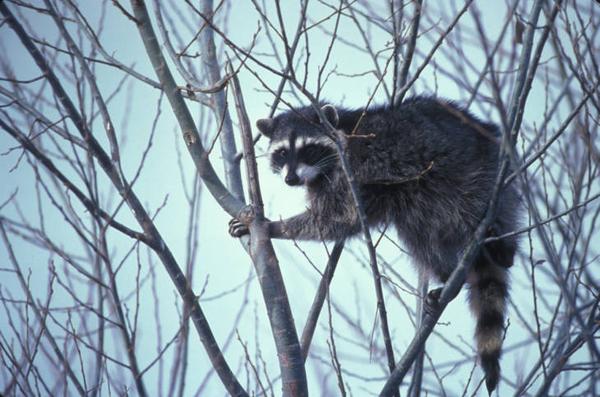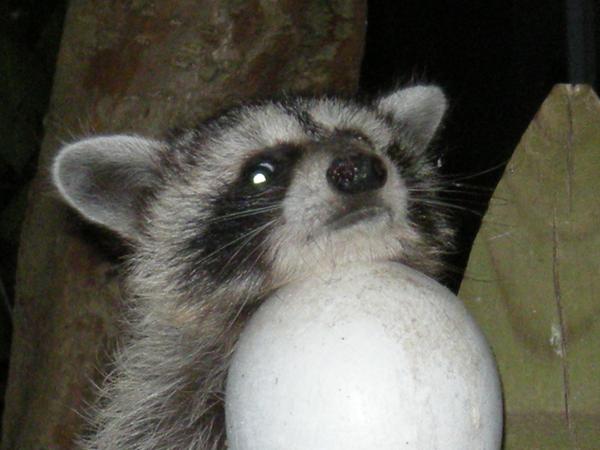Habitat Requirements
Raccoons use a wide variety of land cover types, but generally select areas with a variety of vegetation types and age classes. Bottomland hardwood forests provide diverse foods, including hard mast, insects, and aquatic species. Croplands, fallow fields and other open areas provide fleshy fruits such as berries, insects, and mice or other animal prey. Raccoons depend on wetlands for a large portion of their food and are seldom found far from water. They also are common in urban areas and adapt well to living near people. Female raccoons use cavities in living and dead trees, abandoned burrows, hollow logs, and culverts, for dens.
Food
Raccoons are opportunistic omnivores. When food is plentiful, plant matter is consumed twice as much as animal matter. However, this ratio varies as food supplies change and during different seasons of the year. Raccoons are voracious eaters and tend to return to the same location as long as food is available. Raccoons store fat throughout the fall in preparation for overwintering. Raccoons are not true hibernators, but may sleep for extended periods in colder areas. Some favored raccoon foods include:
Plants
- Wild grape
- Greenbrier
- Black cherry
- Dogwood
- Blueberry
- Beechnuts
- Persimmon
- Blackberry
- Eastern redcedar
- Serviceberry
- Acorns
- Pecans
Animals
- Grasshoppers
- Bird eggs
- Mussels
- Crabs
- Frogs
- Fish eggs
- Earthworms
- Crayfish
- Snails
- Aquatic insects
- Snakes
- Mice
Cover
Both ground dens and cavity trees are used for shelter and escape, but tree cavities are preferred for raising young. Suitable ground dens include old woodchuck or fox burrows, rock crevices, downed trees, abandoned buildings, and brush piles. Active den trees can be identified by claw marks or worn bark. Dens are usually located just below or within the tree canopy. Preferred cavities have 4 to 10-inch openings, are at least 15 feet from the ground, and are sheltered from rain and strong winds.
Water
Raccoons must drink water daily. Permanent sources of open water are a critical part of the habitat.
Home Range
Home ranges average about 200 acres and vary from 1⁄2 to 11⁄2 miles in diameter. During years with varying habitat quality, movement activity and distance may change. For example, raccoons may move long distances when populations are low and food is scarce.
Raccoon Management
Improving Raccoon Habitat
General Forest Management
• Maintain smaller stand sizes from 10 to 50 acres to encourage landscape diversity
• Encourage a variety of forest stand age and composition
• Maintain long rotations for hardwood stands (60 years or more)
• Encourage inclusions of mature hardwood within pine stands
Forest Regeneration
• Consider two-aged regeneration methods (e.g., reserve shelterwood) to maintain cavity trees and hard mast (e.g., acorn) production
• Distribute timber harvests to encourage age, size, and tree species diversity
Intermediate forest treatments
• Avoid use of broad-spectrum herbicides that aim to remove all non-pine plant species
• During thinning and regeneration harvests, retain trees with potential for cavities
• Thin hardwoods to encourage crown growth and mast production
Other improvements
• Mark and leave unharvested stream-side management zones, which will protect water quality and retain mature trees that produce mast and provide cavities
• Create snags when naturally occurring cavities are not abundant
• Leave small unharvested areas of croplands adjacent to woodlands
Many game and nongame species benefit from raccoon management. Management efforts should emphasize the communities of which which raccoons are a part. Common raccoon associates include:
Species that benefit from raccoon management.
- Wild turkey
- White-tailed deer
- Southern flying squirrel
- Pileated woodpecker
- Wood duck
- Great horned owl
- Gray fox
- Gray squirrel
- Black bear
- Virginia opossum
- Northern flicker
- Eastern screech owl
- Red-shouldered hawk
Working With Wildlife
North Carolina State University Extension - Forestry
Working With Wildlife Series
Publication date: April 1, 2019
Reviewed/Revised: Jan. 19, 2024
N.C. Cooperative Extension prohibits discrimination and harassment regardless of age, color, disability, family and marital status, gender identity, national origin, political beliefs, race, religion, sex (including pregnancy), sexual orientation and veteran status.
N.C. Cooperative Extension prohibits discrimination and harassment regardless of age, color, disability, family and marital status, gender identity, national origin, political beliefs, race, religion, sex (including pregnancy), sexual orientation and veteran status.




